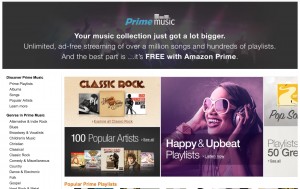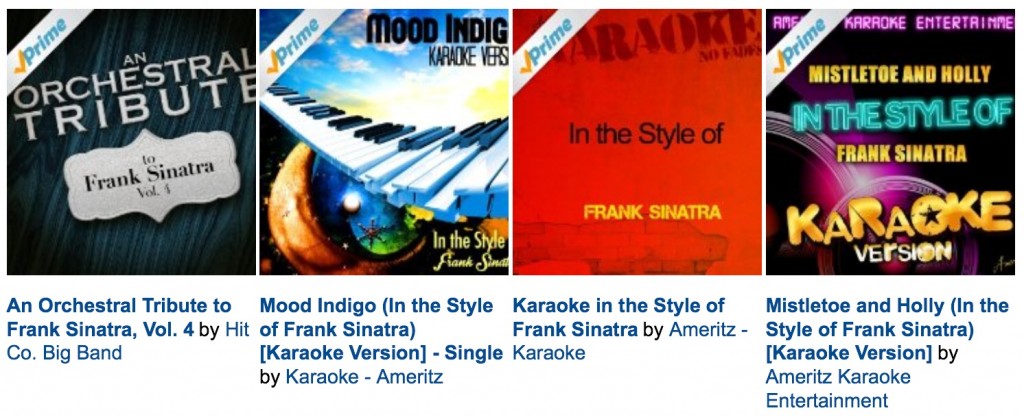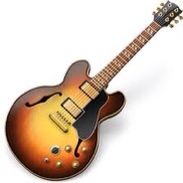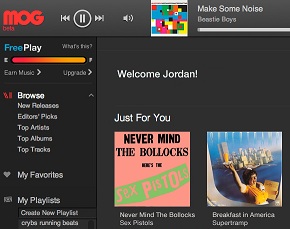After months of rumors, Amazon has rolled out its Prime Music service. As expected, it bundles music with the company’s Amazon Prime service, which now costs $99 a year for new members. And as expected, there are some gotchas.
Prime Music is launching with over a million songs; Spotify, by contrast, has over 20 million, and even that has selection has its holes. Prime doesn’t include current hits. It also doesn’t have anything from Universal Music Group, which owns more music than anyone else.
I’ve been fiddling around with the new service this morning, and it hasn’t gone that well: On my iPad, the new version of Amazon’s music app for iOS is unusably slow and keeps crashing. (The web version of the service works fine.) But that isn’t stopping me from asking questions about it:
1. Is a million songs a lot, or hardly any? Amazon’s own Prime Video and Netflix show us that a movie service can be a keeper even if there are far more things that it doesn’t have than ones which it does. But there does need to be a critical mass of stuff worth caring about.
For me, the lack of current hits is a non-issue: Most of the music I listen to is forty, fifty, or sixty years old. So I wondered whether the service might seem complete to me, or at least substantial.
During my early rummaging around in the Prime collection, however, the pickings still come off as slim. The results for Bob Dylan look great, but much of the time, when I searched for an artist or group I got one or two major albums and a bunch of chaff such as “tributes” and karaoke versions.
I got excited about the 32 albums which came up for “Frank Sinatra” until I saw they included one real Sinatra album (In the Wee Small Hours), three sketchy-looking compilations of his early work as a band singer, and 29 things along the lines of this:
Besides albums, Prime Music offers hundreds of playlists, which seem to benefit from less restrictive licensing. For example, there are no Monkees albums, but a playlist called “The Monkees’ Top Songs” does indeed have 19 of the ones you’re most likely to look for.
2. Is there a place for Amazon Prime given the profusion of free music which is already available? Amazon Prime Video and Netflix make sense in part because they’re offering content which is generally unavailable for free elsewhere (at least legally). But both Spotify and Rdio now offer free versions with way more than a million tracks. They’ve got their own catches: Spotify only lets you listen to music on mobile devices in shuffle mode, and Rdio isn’t free on mobile devices at all. But I still suspect I’d be inclined to go to a service with a far higher chance of having the music I want than Prime Music currently does.
3. Does not having anything from Universal Music Group destroy the service, or merely cripple it? Strangely enough, most of us don’t pay close attention to which enormous corporation controls the work of our favorite performers. So it’s tough to say how much the absence of all this music will hobble Prime for any particular listener. Wikipedia has a helpful list of Universal’s artists, from A (ABBA) to Z (Zucchero).
4. Would anyone cancel a paid account to Spotify or Rdio because this exists? Seems highly unlikely to me.
5. Is it reasonable to say it’s FREE? Amazon is billing Prime Music as being “FREE with Amazon Prime.” I’m not sure how something that involves a $99 yearly fee qualifies as being free. Especially since Amazon recently raised the price of Prime membership, which presumably makes it easier for the company to add inducements such as, um, free music.
6. Will Prime Music get great? Right now, I can’t imagine that anyone will regard this music service as anything other than a pleasant bonus for Prime subscribers, in a category already crowded with excellent options. But Prime Video started out with only a smattering of content, and has grown into an attractive Netflix alternative. Given time, Prime Music might blossom–especially if Amazon and Universal hammer out a deal, and especially if the service expands to include at least some semi-current hits.
Those are all the questions I have right now. If you have opinions on them–or on Prime Music in general–I’d love to hear them.



 In Facebook’s never-ending quest to get you to stay on its site even longer, the site has rolled out a new feature for music services on the social networking site. Now, when those music statuses appear on your newsfeed, clicking on their name will pop up a window with a button to “Listen With” that friend. Making it even more fun, you’ll start the music at the exact same point, essentially allowing your friend to play DJ.
In Facebook’s never-ending quest to get you to stay on its site even longer, the site has rolled out a new feature for music services on the social networking site. Now, when those music statuses appear on your newsfeed, clicking on their name will pop up a window with a button to “Listen With” that friend. Making it even more fun, you’ll start the music at the exact same point, essentially allowing your friend to play DJ.
 If Spotify proved one thing with its U.S. launch, it’s that people will go nuts for free music. So now
If Spotify proved one thing with its U.S. launch, it’s that people will go nuts for free music. So now  The Turntable.fm bug hit me hard about a month ago. Suddenly I was wasting hours DJing alongside my friends, hoarding points to upgrade my avatar and building a big database of cool music that I’d never heard before. All the while, my friends and I asked the same question: Where’s the Turntable.fm smartphone app?
The Turntable.fm bug hit me hard about a month ago. Suddenly I was wasting hours DJing alongside my friends, hoarding points to upgrade my avatar and building a big database of cool music that I’d never heard before. All the while, my friends and I asked the same question: Where’s the Turntable.fm smartphone app? Subscription music service Spotify has announced that it will finally be launching in the United States — at some point. The company, which is known overseas for streaming millions of ad-supported songs on demand at no charge, provided hardly any details on its U.S. plans. Spotify simply confirmed the news and started
Subscription music service Spotify has announced that it will finally be launching in the United States — at some point. The company, which is known overseas for streaming millions of ad-supported songs on demand at no charge, provided hardly any details on its U.S. plans. Spotify simply confirmed the news and started 



 While many of us Google I/O attendees were
While many of us Google I/O attendees were